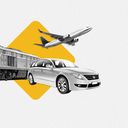The state of transportation: Stuck between tech of the future and security of the past

Published Date: 10/18/2019
Source: axios.com
The transportation industry is teetering between tried-and-true business models of the past and an alluring, but uncertain, future.The big picture: The modernization of cars, trucks, planes and public transit could be one of the greatest reorderings of civilization since the dawn of the horseless carriage. But progress in the $1.5 trillion transportation industry is getting snagged on technological, regulatory and social issues.What's happening: A historic shift to cleaner, more economical, automated transportation is underway.More than 1,400 self-driving cars, trucks and other vehicles are being tested across the country, according to Transportation Secretary Elaine Chao.Electric cars are going mainstream, with 35 battery-powered models available in U.S. showrooms next year and 130 by 2026, per IHS Markit. Cities are rolling out electric bus and rail systems to try to curb emissions as well as congestion pricing to reduce traffic. Fledgling microtransit systems — from on-demand shuttles to e-bikes and scooters — aim to fill the transportation gap in some cities.UPS just won permission to launch the first commercial drone delivery service and Uber, Boeing, Google and others are developing air taxis. All of this change is roiling an industry that provides jobs to 13.3 million people in the U.S. and represents a 9% slice of the U.S. economy. The future, industry leaders predict, is a clean, highly-tuned, multimodal transportation system that includes shared, connected vehicles running on electrons rather than gasoline and in which driving is optional.But that vision is being challenged by unforeseen technical hurdles, crumbling infrastructure and a stalled-out federal government that has yet to create standards and regulations for the coming changes, leaving strapped states struggling to step in.Meanwhile, cars, trucks, planes and ships continue to pump carbon dioxide into the atmosphere, accounting for nearly 22% of global carbon emissions in 2018, per the IEA.President Trump has gone to battle with California over auto emissions laws, causing regulatory uncertainty for automakers during what is likely to be a long court battle. All the while, a culture of convenience is fueling a fast delivery system that is putting more vehicles on the road and more CO2 in the air. Companies have to solve the stubborn technical challenges associated with AVs and EVs, but also figure out how to make money from vehicles that consumers aren't interested in or don't trust.The world's largest automakers — once drivers of employment and the economy — are also weathering labor disputes and are caught up in politics as trade wars persist and the global economy is reordered.What to watch: The specter of disruption is triggering enormous R&D investment by automakers fearful of becoming the next Kodak, Blockbuster or BlackBerry.Spending on AVs, by both traditional automakers and newcomers, is forecast to grow to a cumulative $85 billion through 2025 — on top of the $225 billion spending for EVs, according to Alix Partners.They're all chasing a multitrillion-dollar global market that Boston Consulting Group says is worth $380 billion in profits.But there's no guarantee any of it will pay off. "It’s a gamble based on what you think will happen, but if you don’t do anything, then for sure you’re out of business," says Mike Ramsey, an analyst at Gartner.